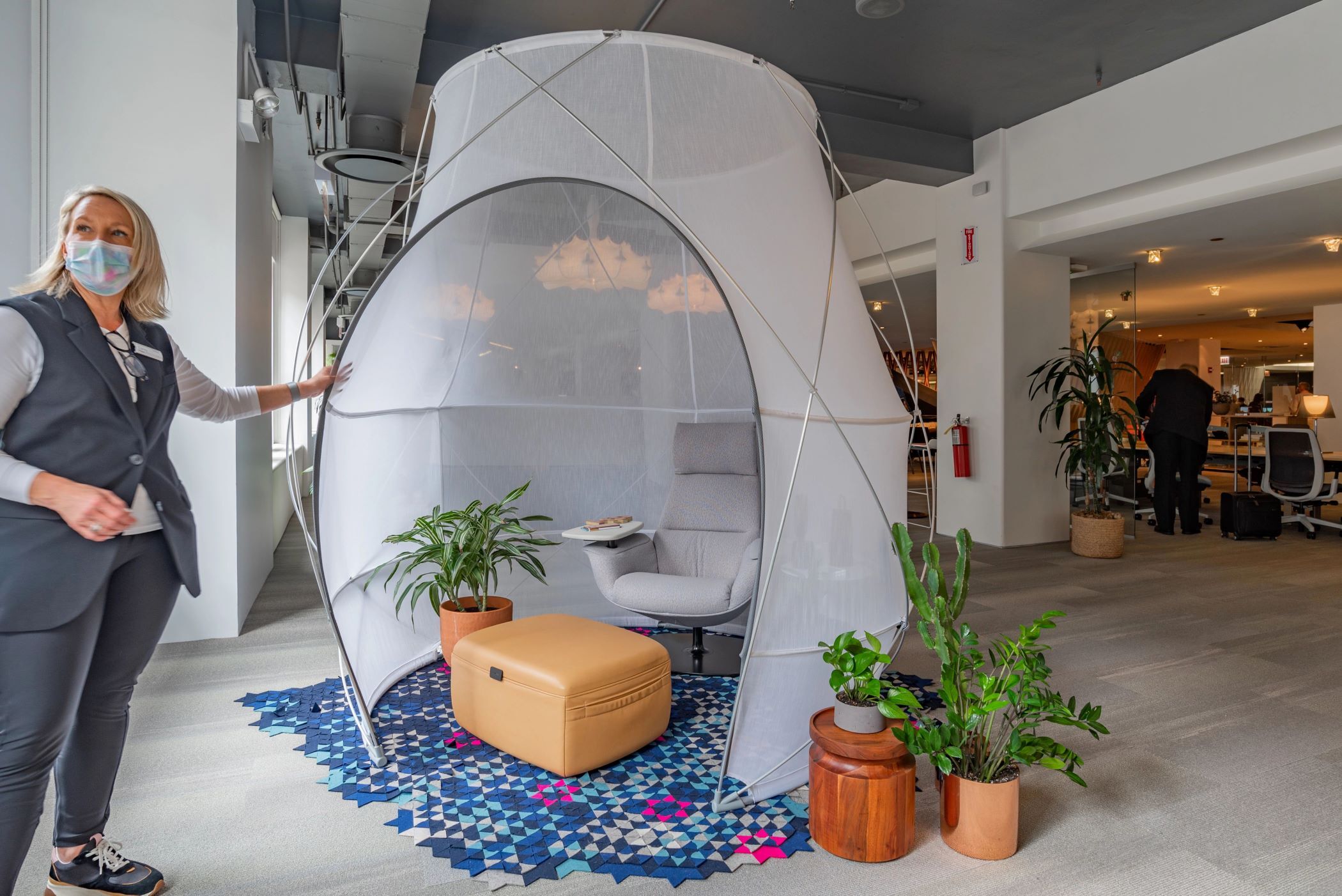Commercial Designers Bet on Touches of Home, Outdoors in COVID-Era Offices

As workers return to the office, they’re increasingly bringing two things with them: comforts of home and the great outdoors.
Those elements played a prominent role in NeoCon, the commercial design industry’s largest gathering, held last week in Chicago.
Tents, slatted pergolas, curtained break rooms and soft furniture were on display at the event that was held last week, as companies continue to coax workers back to the office more than year and a half into the COVID-19 pandemic.

Thoughtful design is an effective way to reintroduce workers to the corporate setting, NeoCon vendors said.
“What we are seeing as one of the major trends is, when all of us went home we were missing the accoutrements of the office, the technology,” said Leslie Eichelberger, director of marketing at office furniture maker The HON Company. “Our businesses all helped us get set up at home. But now that we’re all coming back to the office, people are missing the comforts of home.”
HON, part of Muscatine, Iowa-based HNI Corp., showcased a variety of office configurations, including home-like seating such as couches and soft chairs. It’s also showing off products for those who continue working from home, at least part of the time, such as smaller office chairs.
NeoCon is held annually at theMART, the massive building formerly known as the Merchandise Mart, along the Chicago River. A consistent theme at the first pandemic-era NeoCon is furnishings that provide a variety of work settings, particularly for offices with open layouts. Many of the products existed or were in development before offices began shutting down in March 2020, but they’ve gained relevance since the onset of the health crisis.
One example is a line of office tents from Steelcase, which is known for traditional furnishings such as chairs.
This year, Steelcase has rolled out four varieties of tents that are popular among open-layout tenants such as tech firms, said Carey Potter, a communications manager at the firm based in Grand Rapids, Michigan.
“These were actually envisioned prior to the pandemic,” Potter said. “The pandemic, everyone was thinking about how they can protect themselves a little bit better. It was just good timing.”

Sizes range from a desktop model to a canopy-like covering for small meetings. The pod tent has room for one person to sit in a relaxing chair or to work from a single desk and office chair.
Tents are made of sheer and camping tent-like materials. They’re not meant to protect workers from the spread of air particles, but they create some distance and limit distractions as people reorient themselves to working in a busy office, Potter said.
“The pod tent is doing really well,” Potter said. “It adds such a nice, organic type of element to an office space that’s typically linear. It’s soft and airy and really inspired by the original tent, which was designed to provide shelter and protection when you’re out in nature. This provides shelter and protection from office distractions.”
From Backyards to Offices
Another company offering a hint of the outdoors is Holland, Michigan-based Haworth. Its Pergola products are a backyard staple. Now they’re also being incorporated into offices, particularly in the Big Tech industry, product specialist Andrew Peterson said.
On display at NeoCon was a slatted, circular structure that can be used for team meetings.
“It’s about biophilia [the human instinct to connect with nature] and harvesting daylight,” Peterson said. “It wasn’t a response to the pandemic. We saw it evolving before the pandemic.”
The Pergola line also includes an L-shaped structure that fits along a wall, with sections for individual relaxation and small meetings. Drapery is used for privacy.

“The goal is to bring something more intimate in scale to the office rather than just formal conference rooms,” Peterson said. “You’re bringing in the outside, accompanied by daylight and natural plants. It’s not rows of cubicles, rows of conference rooms. It’s variety in the size of the spaces that people occupy."
“We learned that we all need different things. Some people work better on a couch. Some people work better at a formal table. Some people still appreciate the desk with the double monitor."
Another existing product that’s gaining new applications is glassy, enclosed structures that resemble phone booths, such as those made by The Framery.

The Tampere, Finland-based firm had several sizes on display at the Chicago event, ranging from single occupancy booths to units that could accommodate four to six employees.
The firm was created in 2010 to address noise distractions in open layouts, and its soundproof products are evolving to accommodate technology needs such as connectivity for online meetings, said Reid Ruberti, The Framery’s director of the Americas.
“What we’re seeing is that as people reconfigure how they go back to work, they also need to reconfigure the floor plate,” Ruberti said. “We’re basically selling a self-contained pod that’s movable and fully soundproof, where you don’t have a construction project going on around you.”
The Framery’s sales lagged in 2020 as offices all but shut down, but the firm saw a spike in orders in June and July as employers began to anticipate an end-of-summer increase in office occupancy, he said. The return to 2019-level sales volume diminished the supply of products in U.S. warehouses, and the company is now shipping several dozen pods from Finland, Ruberti said.
“Forecasting is probably our biggest challenge these days,” he said. “We’re kind of catching up on the demand that we didn’t anticipate coming into the summer.”

